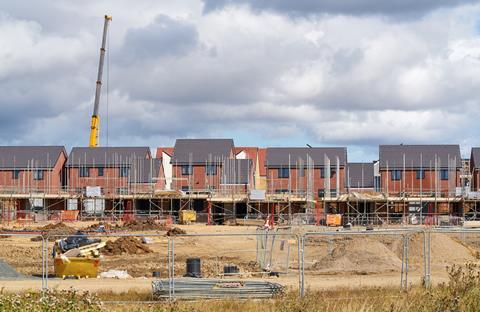Savills report urges ministers to ramp up grant funding as private sector contributions slip away

The government will need to radically step up its investment in affordable housing if it is to have any chance of hitting its ambitious target of building 300,000 homes a year from the mid-2020s, according to a new report from Savills.
Government funding for affordable homes is currently running at just 12% of a home’s building cost, down from 50% before the financial crash of 2007/08. But if ministers were to bump that up again it would add to, rather than displace existing investment from the private sector, Savills argued.
The report, co-sponsored by the G15 group, the National Housing Federation and Homes for the North, called for more joint venture activity between the private sector, housing associations and councils and more use of long-term funding models such as the strategic partnerships created by the Greater London Authority and the government’s housing delivery agency Homes England.
Paul Hackett, chair of the G15 and chief executive of housing association Optivo, said increasing grant funding for affordable housing would reduce the market risk that housing associations were currently exposed to and help organisations like his build during downturns.
“Our sector is reliant on a cross-subsidy model where the money we make from private housebuilding is reinvested into affordable homes. But this model is at full stretch and massively exposed to the market.
“Savills’ report shows that a new funding deal for affordable housing is now imperative if the government wants to hit its housing targets over the next decade.”
Hackett told Housing Today that while there had been several positive policy initiatives in the past couple of years it was vital that a long term deal, stretching between 2022 to 2032, with higher grate rates, was put in place to help housing associations to build more homes.
“We’re spending £24bn on housing benefits. Spending a billion on people who are waiting to be housed. Surely it’s better to spend that money on building more affordable homes that these people can actually live in?”
Meanwhile the slowdown in the private market and Help To Buy’s winding down towards – possibly – being withdrawn altogether, represented what Savills called “a significant downside risk to speed and scale of development for the majority of developers, including housing associations, unless there is a major shift in mortgage market conditions to support buyer demand”.
The report said there was an annual shortfall of at least 60,000 affordable homes a year and that based on affordability alone the annual need for additional affordable housing in England was 2.6 times greater than supply, rising to a multiple of 7.6 in London.
To hit the government’s 300,000 homes a year target by 2025 will require annual growth of 3.4%, the report argued, but annual growth rates in total completions of the nine major housebuilders, who accounted for around 40% of total new build completions, had been declining from 11% in 2014 to 3% in 2018.
Kate Henderson, chief executive of the National Housing Federation, said: “This research shows that relying on private developers to end the housing crisis is fatally flawed. Without government investment in affordable housing, it just won’t be possible to build enough homes to ensure that everyone can have somewhere stable and affordable to live.
“If we are serious about ending the housing crisis, the government must do the right thing and invest in affordable housing at the upcoming spending review. Doing nothing is simply not an option.”











No comments yet